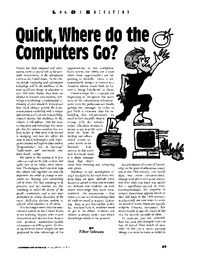Quick, where do the computers go?Erstpublikation in: Communications of the ACM, Volume 34 , Issue 2 (February 1991)
Publikationsdatum:
|
 |
 Diese Seite wurde seit 2 Jahren inhaltlich nicht mehr aktualisiert.
Unter Umständen ist sie nicht mehr aktuell.
Diese Seite wurde seit 2 Jahren inhaltlich nicht mehr aktualisiert.
Unter Umständen ist sie nicht mehr aktuell.
 Zusammenfassungen
Zusammenfassungen
 History has dealt computer and information science a special role in the inevitable restructuring of the educational system in the United States. In the coming decade computing and information technology will be the backbone of the most significant change in education in over 100 years. Rather than being an adjunct to learning and teaching, technology is facilitating a fundamental re-thinking of what should be learned and how. Such changes present the Communications readership with a unique opportunity and a serious responsibility. Toward meeting this challenge, in this column I will address some key issues in education and technology. For example, this first column examines how our basic notion of what needs to be learned is changing, and how this affects the ways in which technology is used. Subsequent columns will explore topics such as “programming's role in learning,” “multi-media, and nationwide, computer-based,” testing.
History has dealt computer and information science a special role in the inevitable restructuring of the educational system in the United States. In the coming decade computing and information technology will be the backbone of the most significant change in education in over 100 years. Rather than being an adjunct to learning and teaching, technology is facilitating a fundamental re-thinking of what should be learned and how. Such changes present the Communications readership with a unique opportunity and a serious responsibility. Toward meeting this challenge, in this column I will address some key issues in education and technology. For example, this first column examines how our basic notion of what needs to be learned is changing, and how this affects the ways in which technology is used. Subsequent columns will explore topics such as “programming's role in learning,” “multi-media, and nationwide, computer-based,” testing. Dieser wissenschaftliche Zeitschriftenartikel erwähnt ...
Dieser wissenschaftliche Zeitschriftenartikel erwähnt ...
 Personen KB IB clear | Jerome S. Bruner , Seymour Papert | ||||||||||||||||||||||||||||||||||||
 Fragen KB IB clear | Welche Ausbildung wird in der Informationsgesellschaft benötigt? | ||||||||||||||||||||||||||||||||||||
 Bücher |
|
 Zitationsgraph
Zitationsgraph
 Zitationsgraph (Beta-Test mit vis.js)
Zitationsgraph (Beta-Test mit vis.js)
 Volltext dieses Dokuments
Volltext dieses Dokuments
 |  Quick, where do the computers go?: Artikel als Volltext ( Quick, where do the computers go?: Artikel als Volltext ( : :  , 218 kByte; , 218 kByte;  : :  2020-11-28) 2020-11-28) |
 Anderswo suchen
Anderswo suchen 
 Beat und dieser wissenschaftliche Zeitschriftenartikel
Beat und dieser wissenschaftliche Zeitschriftenartikel
Beat war Co-Leiter des ICT-Kompetenzzentrums TOP während er Dieser wissenschaftliche Zeitschriftenartikel ins Biblionetz aufgenommen hat. Die bisher letzte Bearbeitung erfolgte während seiner Zeit am Institut für Medien und Schule. Beat besitzt kein physisches, aber ein digitales Exemplar. Eine digitale Version ist auf dem Internet verfügbar (s.o.). Aufgrund der wenigen Einträge im Biblionetz scheint er es nicht wirklich gelesen zu haben. Es gibt bisher auch nur wenige Objekte im Biblionetz, die dieses Werk zitieren.










 Biblionetz-History
Biblionetz-History